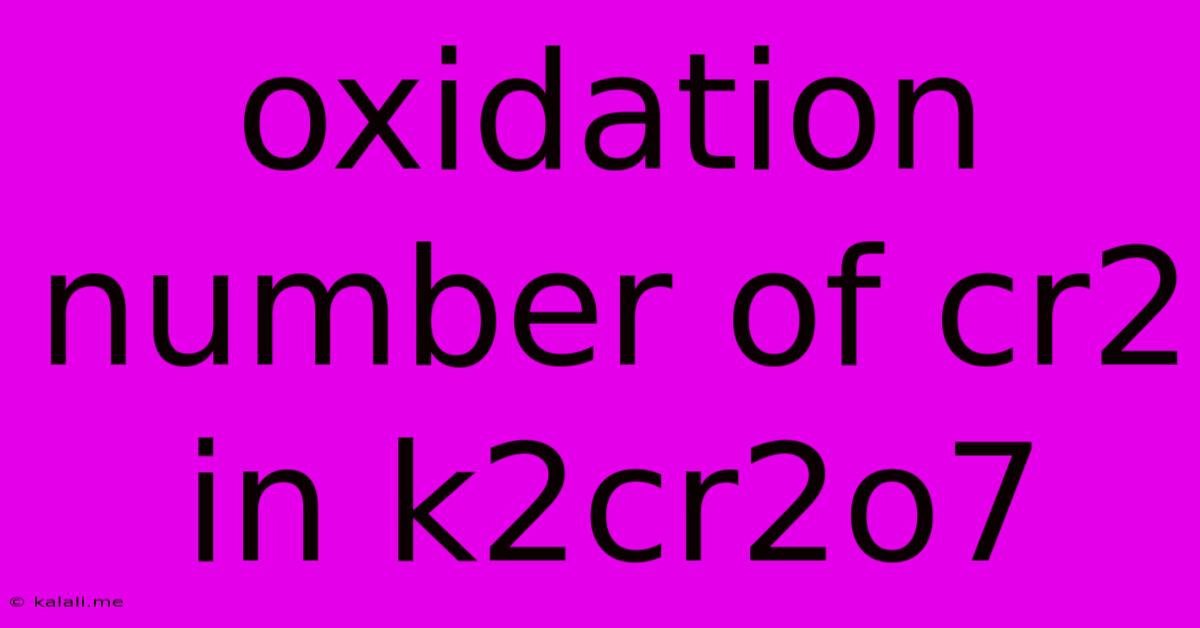Oxidation Number Of Cr2 In K2cr2o7
Kalali
Jun 14, 2025 · 3 min read

Table of Contents
Determining the Oxidation Number of Cr in K₂Cr₂O₇
Potassium dichromate (K₂Cr₂O₇) is a vibrant orange, crystalline compound commonly used in various chemical applications, from laboratory reagents to industrial processes. Understanding the oxidation state of chromium (Cr) within this compound is crucial for predicting its reactivity and behavior in chemical reactions. This article will guide you through the process of calculating the oxidation number of Cr in K₂Cr₂O₇. We'll break it down step-by-step, making it easy to understand even for those new to oxidation states.
Understanding Oxidation Numbers
Before we dive into the calculation, let's briefly revisit the concept of oxidation numbers. An oxidation number (also known as oxidation state) represents the hypothetical charge an atom would have if all bonds to atoms of different elements were completely ionic. It's a useful tool for balancing redox reactions and understanding the electron transfer involved. Remember, oxidation numbers are assigned based on a set of rules, which we'll use to determine the oxidation state of chromium in K₂Cr₂O₇.
Rules for Assigning Oxidation Numbers
To determine the oxidation number of Cr in K₂Cr₂O₇, we'll need the following rules:
- The oxidation number of an uncombined element is zero. (e.g., the oxidation number of O₂ is 0)
- The oxidation number of a monatomic ion is equal to its charge. (e.g., the oxidation number of Na⁺ is +1)
- The oxidation number of hydrogen is +1, except in metal hydrides where it is -1.
- The oxidation number of oxygen is -2, except in peroxides (like H₂O₂) where it is -1, and in superoxides where it is -1/2.
- The sum of the oxidation numbers of all atoms in a neutral molecule is zero.
- The sum of the oxidation numbers of all atoms in a polyatomic ion is equal to the charge of the ion.
Calculating the Oxidation Number of Cr in K₂Cr₂O₇
Now, let's apply these rules to K₂Cr₂O₇:
-
Potassium (K): Potassium is an alkali metal and always has an oxidation number of +1. Since there are two potassium atoms, the total positive charge contributed by potassium is +2 (2 x +1 = +2).
-
Oxygen (O): Oxygen typically has an oxidation number of -2. There are seven oxygen atoms in K₂Cr₂O₇, contributing a total negative charge of -14 (7 x -2 = -14).
-
Chromium (Cr): Let's represent the oxidation number of chromium as 'x'. Since there are two chromium atoms, the total contribution from chromium is 2x.
-
Applying Rule 5: The sum of the oxidation numbers in a neutral molecule is zero. Therefore, we can set up the equation:
(+2) + 2x + (-14) = 0
-
Solving for x:
2x = 12 x = +6
Therefore, the oxidation number of chromium (Cr) in K₂Cr₂O₇ is +6.
Conclusion
The oxidation number of chromium in potassium dichromate (K₂Cr₂O₇) is +6. This information is vital in understanding the chemical properties and reactivity of this important compound in various chemical reactions and applications. Understanding how to determine oxidation numbers is a fundamental skill in chemistry, allowing you to predict and interpret chemical processes with greater accuracy. Remember to always apply the rules systematically and double-check your calculations.
Latest Posts
Latest Posts
-
A Small River That Joins A Larger River Is A
Jun 14, 2025
-
Which Of The Following Are Mechanical Waves
Jun 14, 2025
-
What Is The Factor Of 216
Jun 14, 2025
-
First Indian Gold Medal In Olympics
Jun 14, 2025
-
Which Of The Following Is A Measure Of Variability
Jun 14, 2025
Related Post
Thank you for visiting our website which covers about Oxidation Number Of Cr2 In K2cr2o7 . We hope the information provided has been useful to you. Feel free to contact us if you have any questions or need further assistance. See you next time and don't miss to bookmark.